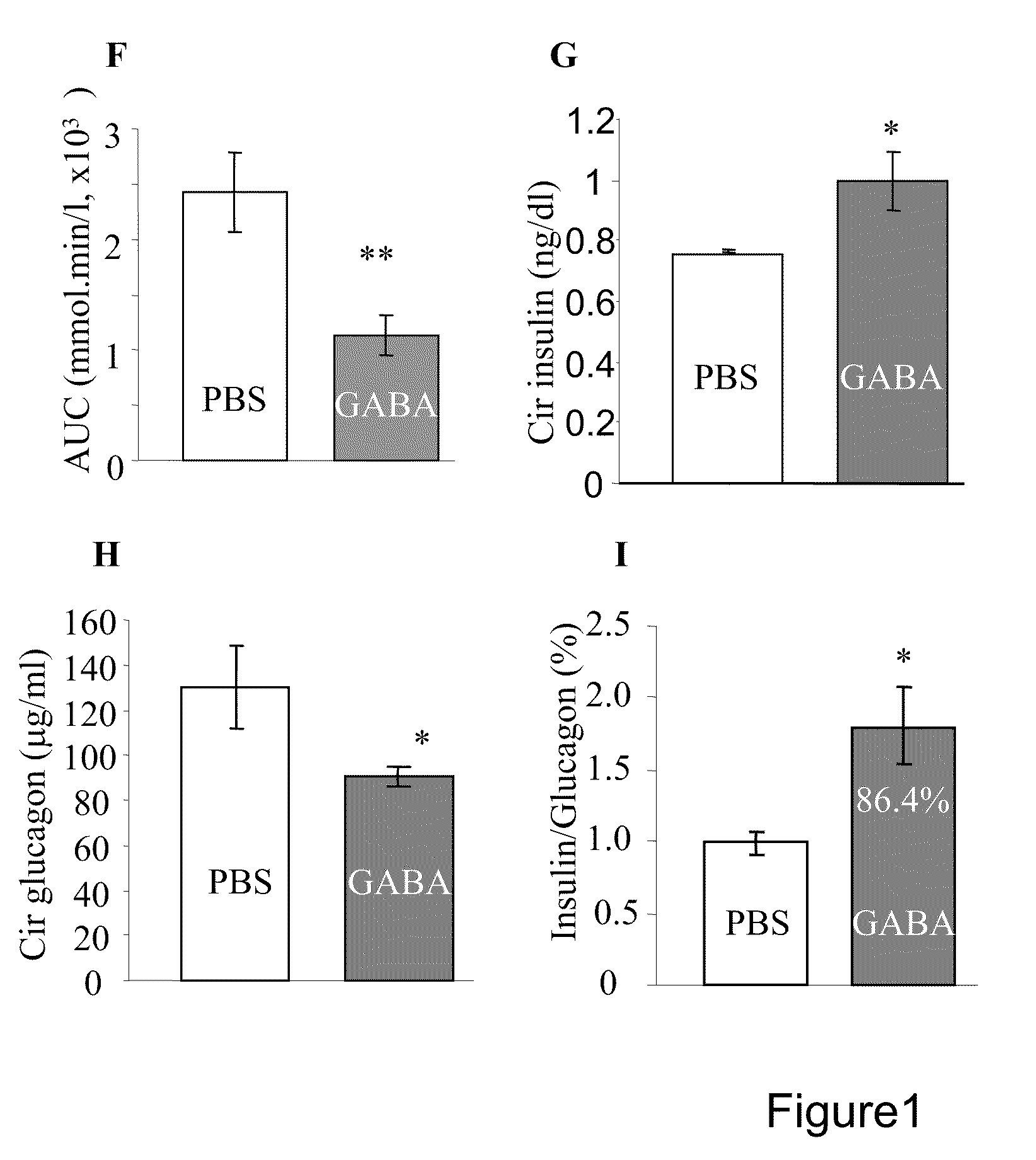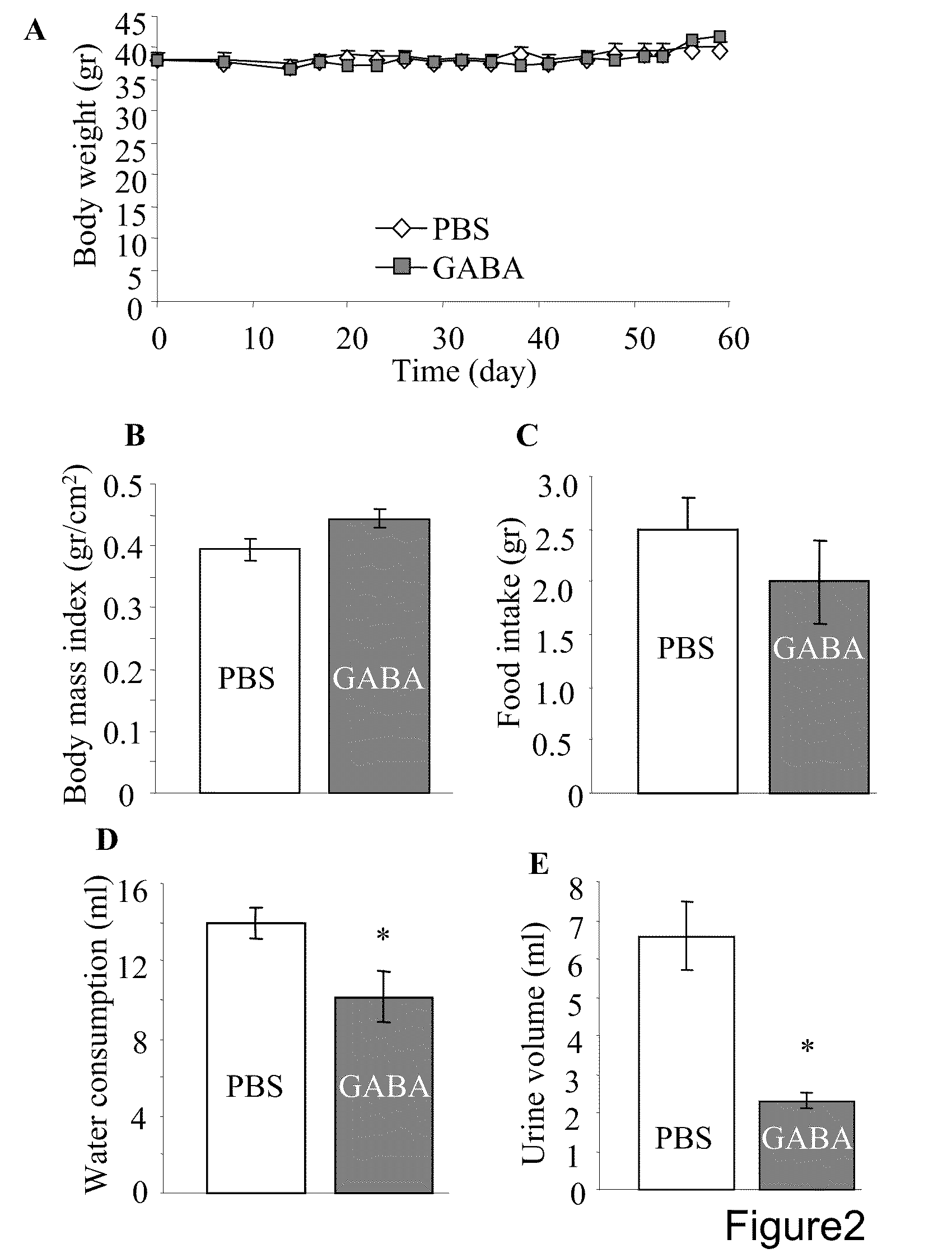Method of ameliorating symptoms of type 1-diabetes using GABA related compounds and GLP-1/exendin-4 compounds
a gaba-related compound and type 1 diabetes technology, applied in the field of composition and treatment of type 1 diabetes, can solve the problems of diabetic hyperglycemia, insulin is not a cure, and significantly reduced beta-cell mass, etc., to suppress beta-cell autoimmunity, reduce beta-cell apoptosis, and increase beta-cell proliferation
- Summary
- Abstract
- Description
- Claims
- Application Information
AI Technical Summary
Benefits of technology
Problems solved by technology
Method used
Image
Examples
example 1
[0149]As shown in the FIG. 1, the diabetes induction by multiple-low-dose-streptozotocin (i.p. 40 mg / kg for four consecutive days, MLDS) in mice can be prevented by daily injection of GABA. The MLSD murine model is commonly used for study of T1D (Rossini A A et al, 1978 Nature. 276(5684):182-4; Harlan D M et al, 1995 Diabetes 44(7):816-23) in which the beta-cells are destroyed by the toxic streptozotocin that leads to insulin insufficiency. To certain extent, T-cell mediated beta-cell inflammation (insulitis) is found in the multiple-low-dose streptozotocin induced diabetic hyperglycemia. However, insulitis may not be necessary occurred in the hyperglycemic mice induced by one injection of streptozotocin of high dose (i.e. 200-250 mg / kg), as in the latter case the beta-cell are rapidly destroyed. Therefore, MLDS is a model of beta-cell injury, to certain degree insulitis, but an ideal autoimmune disease model (Gerling I C et al, 1994 Diabetes; 43, 433; Giarratana N et al, 2007 Metho...
example 2
[0198]Effects of GABA on stimulation of GLP-1 secretion from gut-derived cell lines. The production and secretion of GLP-1 in the gut-derived cells (STC-1) are examined by GLP-1 RIA. The time and dose dependent effects of GABA on GLP-1 production and secretion are examined in the gut cell lines in the presence of various concentration of GABA in which the specificity is determined by including the GABAAR antagonists in the assay.
[0199]Effects of Ex4 on secretion and production of GABA in insulin-secreting beta-cells. GABA concentrations were determined by the Free Amino Acid Analysis. This was performed on a Waters Acquity HPLC System. INS-1 cells were grown in a 12-well plate. After overnight starvation in a serum-free medium, the cells were incubated with or without GLP-1, Ex4 (7-39) in the presence or absence of Ex9 (9-39) for various time points including 0, 2, 24 hrs. The specificity of the action of GLP-1 on GABA production and release is verified by including the assay the us...
PUM
| Property | Measurement | Unit |
|---|---|---|
| weight | aaaaa | aaaaa |
| time | aaaaa | aaaaa |
| time | aaaaa | aaaaa |
Abstract
Description
Claims
Application Information
 Login to View More
Login to View More - R&D
- Intellectual Property
- Life Sciences
- Materials
- Tech Scout
- Unparalleled Data Quality
- Higher Quality Content
- 60% Fewer Hallucinations
Browse by: Latest US Patents, China's latest patents, Technical Efficacy Thesaurus, Application Domain, Technology Topic, Popular Technical Reports.
© 2025 PatSnap. All rights reserved.Legal|Privacy policy|Modern Slavery Act Transparency Statement|Sitemap|About US| Contact US: help@patsnap.com



